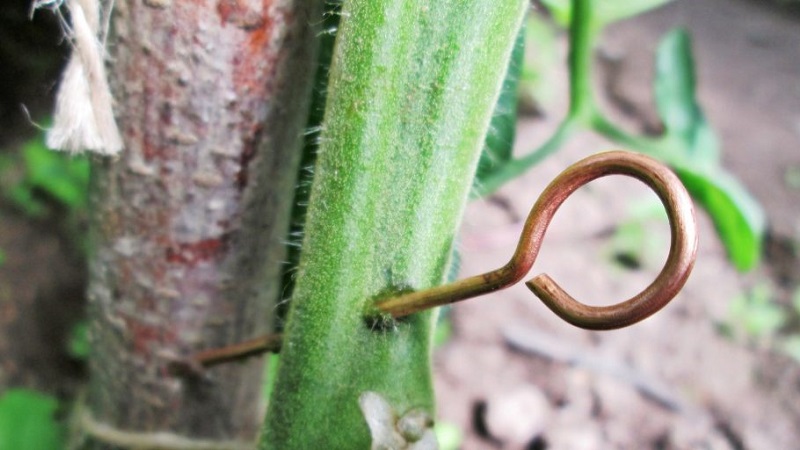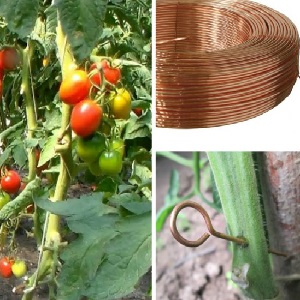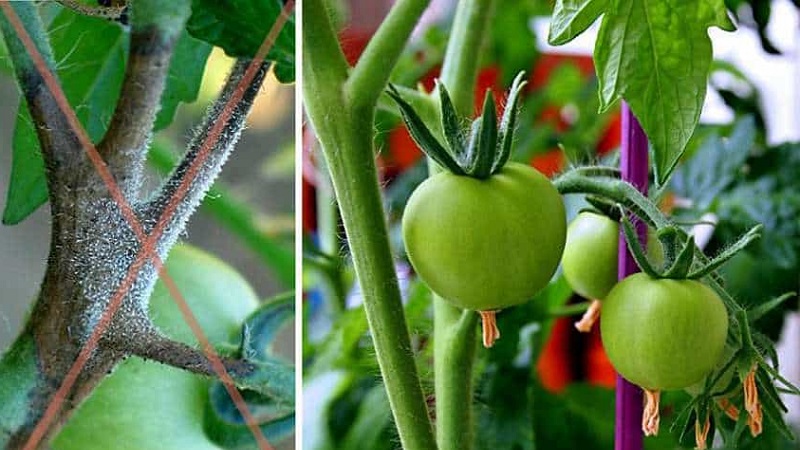Rescue with copper wire from late blight on tomatoes - myth or reality: full analysis
Late blight is a disease that annually destroys crops in hundreds of sites. The disease is especially dangerous for nightshade crops, including tomatoes. To save tomatoes, gardeners use many methods and even such exotic ones as using copper wire.
But does this method work in practice? And if so, how to use the wire correctly to keep the crop from late blight? You will find detailed answers to these questions in our article.
The content of the article
What is the nature of the disease
First of all, let's figure out what late blight is. The causative agent of the disease is the fungal organism phytophthora of the same genus... There are many varieties of these fungi, but the most dangerous and most common is Phytophthora infestans.
Phytophthora is capable of destroying the harvest of all nightshade crops on the site in one season - potatoes, tomatoes, eggplants, peppers. Sometimes she moves to strawberries, and if she is especially unlucky, even to garden trees, in particular, to apple trees.

Phytophthora affects absolutely all plant organs - from flowers to roots... Cracks and black rot spots form on them. Secondary infection with other types of fungi and pathogenic bacteria occurs through the cracks.
The fruits affected by late blight lose their presentation, quickly rot, have an unpleasant taste and are not stored. The neglected forms of late blight end in the complete death of plants on the root.
Influence of copper
It is known that copper and most fungi are not compatible with each other... Copper compounds quickly and effectively destroy mycelium cells, destroying the entire colony. The action of such proven antifungal drugs as a solution of copper sulfate (copper sulfate) and Bordeaux liquid (sulfate with the addition of lime suspension) is based on this.
And as a result, many gardeners came up with the idea: if copper kills fungi - maybe it is worth using "heavy artillery", that is, pure copper? And experiments began with pieces of copper wire.
It can be useful:
How to treat tomatoes with iodine from late blight
Copper wire from late blight - myth or reality
Let's put it bluntly: agronomy is wary of the use of copper wire... This method of fighting fungi is not officially recognized as effective. Moreover, in some cases, wire puncture of leaves and stems can lead to the death of the plant or the entry of non-fungal pathogens into the wound.
For the first time, such a method of struggle was described in the popular book "Advice for gardeners" by AI Spiridonova and EA Chenykaeva back in 1974. No serious experiments were carried out in the USSR and Russia, and foreign ones gave results that do not allow unambiguously recognizing the method as useful or ineffective.

At the same time, copper cannot be called completely useless.... In the air, it gradually oxidizes, and its compounds and ions, along with the movement of the juices, are carried throughout the tomato bush. Late blight cells penetrating into tomatoes may well die as a result.
Another thing is that it is impossible to even approximately calculate the amount of copper entering the plant in this case, which means that cases of overdose are quite likely.And copper - we must not forget about it! - for a person it is quite poisonous, and a plant is of little use from it in such an amount.
Important. The use of copper wire can only be considered as an experimental auxiliary method of protection against late blight. A banal solution of vitriol will be much more useful, and even modern fungicides will give the wire a hundred points ahead.
Application of copper wire in practice
First of all, it is worth remembering: the wire is used only for mature plants, on which all ovaries have already formed... Injury to young bushes is absolutely unacceptable: crop losses will be comparable to those caused by late blight itself.
To protect against late blight copper wire is used in several ways:
- Like a garter for the stems. Even if the preventive benefit is questionable, it is much more convenient to tie up copper wire than, for example, with synthetic material: the wire bends easily, tightly fixes the plant without injuring it once again, and at the same time does not decompose over the summer, like, say, jute twine - therefore one and the same garter can be used for many years in a row.
- Punching the bases of the trunks with pieces of thick wire. The most questionable use case, the effectiveness of which has not been proven.
- Tying the roots. This method was developed in Germany. In this case, when planting seedlings from copper wire, a ring is formed in the ground, inside which a bush is planted. A wire with a cross section of about half a millimeter and a length of about 50 cm is used.
- Placing a piece of copper in the hole when planting seedlings. In theory, it should work, in practice, gardeners diametrically disagree in assessing the effectiveness of this method.

How to use copper wire correctly
For copper wire to have the maximum preventive effect, follow a few simple rules:
- The impact of the wire should be minimally traumatic to the plants. The best option is to tie with wire, tie the roots and lay in the holes. It is better to refrain from punctures.
- If choosing stem piercing, select only mature shrubs. A puncture at the seedling stage, as many practice, leads, at best, to depressed plant development.
- When piercing, the ends of the wire should not be wrapped around the stem - this will interfere with its growth. If the wire interferes with the care of the plant, it is better to shorten it and bend the ends down.
- Use wire free of surface oxide film and insulation. Remove the insulation, and the "skewers" for the puncture - clean them with sandpaper or a sharpening stone to a shine.
Read also:
How to save tomatoes from late blight if they are already sick
How and what to treat tomatoes from late blight in the open field
Prevention of late blight with copper wire
 In theory, prevention of late blight with copper wire is as follows:
In theory, prevention of late blight with copper wire is as follows:
- Under the influence of the juice in the stems, copper enters into chemical reactions with plant components.
- Compounds and ions of copper with a current of nutrients are distributed throughout the tomato bush.
- When the fungus tries to start colony formation, copper compounds inhibit the growth of its cells, and late blight dies.
By itself, this method looks rather dubious.... The oxide film that forms on the surface of the copper quite well insulates the bulk of the metal from contact with the cells of the tomato bush - and as a result, very little copper enters the plant.
In addition, fungicides containing copper act in a contact manner - they do not penetrate into the plant, but form a film on its surface.
Important: In most cases, wire saturation of a tomato bush with copper ions is similar to treating iron deficiency anemia in humans with nail piercings. Medicine does not recognize such treatment. But it is possible that it can help some individuals.
Gardeners' opinions
As with any controversial method, the opinions of practitioners are diametrically opposed. That's just several reviews on the use of copper wire as a preventive measure against late blight:
- “I have been piercing tomatoes with thin wires for 12 years already. Until now, they have never had a single outbreak of phytophthora. But on the potato bushes growing nearby, no, no, it happens. "
- “I use wire, but it's not a panacea. If you rely only on her, the crop will die. Additionally, I observe crop rotation, every five years I pickle the plot with a strong solution of vitriol, and for irrigation in the summer I use Fitosporin. "
- “Phytophthora hit all the bushes in the open field. To save the tomatoes at least in the greenhouse, I pierced all the plants with copper skewers. There was not a single case of the disease. "
- “I use wire, but I can't figure out if there is any benefit from it. Phytophthora is not present - but the neighbors do not have it either, but they do not pierce copper, water it with fungicides.
- “The method doesn't work! I read about him in a magazine, tried it in a greenhouse - I still had to destroy all the bushes! "
- “Noodles on the ears of gardeners and obscurantism! Tomatoes assimilate copper only in soluble forms - and in the stems, no acid circulates to dissolve the wire. Vitriol is even more useless "
Important... The full range of responses to this practice is intentionally provided here. To use the method or not is up to everyone to decide.

Additional tips for treating the disease
Treating phytophthora is more difficult than preventing its occurrence.... Therefore, even in those cases when a wire is used, punctures or a garter are made not when late blight has already begun, but in advance, even before the main outbreak of the disease.
Don't forget about other measures:
- Modern microbiological preparations work great as a measure of protecting tomatoes from fungus. For example, "Fitosporin" is good in its various forms. Its advantage is that it is based on the culture of living soil bacteria, which means that an overdose is extremely unlikely, the excess bacteria will simply die.
- The synthetic fungicides "HOM", "Ordan", etc. are also effective.
- Avoid dampness and thickening of the beds. No prophylactic agent will help if favorable conditions are created for the development of late blight.
- Use a bed mulch with rotted straw. It contains hay bacillus - a beneficial bacterium that inhibits fungi and pathogens.
- Careful observance of crop rotation is the most important condition for a good harvest!
Preventing late blight is much easier than curing it. And copper wire is only part of the preventive measures.
Conclusion
The use of copper wire against late blight on tomatoes is an extremely controversial method. And in any case, it cannot be the only way to fight: copper does not cancel preventive measures and the use of modern fungicides.
Is it worthwhile to bother with copper skewers and straps at all - it is up to each gardener to decide for himself: the opinions of practitioners in this matter are diametrically opposite.